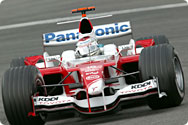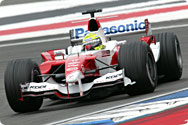| Hello, everyone. As always, thank you for visiting the official Panasonic Toyota Racing website. Takahashi here with a report on Friday and Saturday’s events from the German GP.
Well, we were able to prove our speed during qualifying at the British GP two weeks ago, but in all honesty, I can’t say that we were satisfied with how the race turned out. Both of our cars completed the race, but only one finished in the points, so we fell short of our goal of a dual-points finish. With the German GP in Hockenheim, only two hours by car from TMG headquarters in Cologne, we dearly want get back to the podium here at “home.”
• Tire use to blame for our poor form at the British GP
After the British GP, we went back to the factory and poured over our data. Although we can’t say with 100% assurance, we believe we’ve been able to identify the reason we weren’t able to keep the pace during the first stint of the British GP. I can’t go into too much detail, but it appears that the issue was a problem with the way we were using our tires. We have taken steps to prevent this from happening again, but when we actually reached Hockenheim, we encountered cooler
weather than we’ve ever seen before at this circuit in the past. What’s more, the weather reports indicate a chance of rain on Friday and Sunday. It looks like the German GP will develop under somewhat different conditions than we anticipated.
We haven’t made any significant aero updates for this race, so you won’t see any apparent physical changes to the car. But I have to say that we’ve made great strides in the evolution of our engine. In fact, we decided that rather than using the new spec engine we originally planned for Germany, we would go ahead and introduce an even newer spec engine. We brought two engines to our testing at Jerez after the British GP—one engine planned for this race in Germany, and one
engine we planned to introduce later in Italy. Our “Italian” engine featured quite a bit more horsepower and RPMs than the “German” engine—our drivers could actually feel the difference between the two. And although we had some concerns about reliability, our subsequent bench testing proved that the “Italian” engine had proper reliability for two races, so we made a snap decision to use the newer spec engine in Hockenheim, rather than waiting for the Italian
GP.
On a circuit like Hockenheim that features a long straight, engine power becomes a valuable weapon. Normally, if you want to save time on this circuit, you would add downforce to emphasize performance in the infield section in Sector 3. But the price of doing this is sacrificing top speed, which is actually a disadvantage during the actual race. In rare contrast to most of the recent circuits we have run, Hockenheim has a definite overtake point—the hairpin at the end of the long straight.
Here, you have a good chance to pass a car in front. Considering the actual race conditions, it’s better to put together a setup that allows you to hit maximum speed. The ideal setup sacrifices some downforce for the sake of maximizing top speed, while still allowing the car to move quickly through Sector 3.
• Happy with our performance, but not happy with our qualifying position
The weather forecast called for a high chance of rain on Friday afternoon, so we put together settings on a schedule that would help us complete our program before the rain. Normally, we wouldn’t take many laps on a Friday morning before the track surface has built up. As expected, the track was extremely slippery, causing us a lot of trouble with tire graining. It looked like a lot of teams used two sets of new tires Friday morning.
 |
|
 |
 |
 |
| Look at the difference in front wing shape. Ultimately, the same one will be used, but many different bolt-on parts were tried during setup testing.
|
|
As soon as the Friday afternoon session started, we put out all three of our cars onto the course. We wanted to finish our program as quickly as possible and get in before the rain. Ultimately, it didn’t rain during the session, but we were able to get all of our tire data without incident, so I guess you could say that we had a pretty good Friday. Our prime tires had issues coming up to temperature properly, and the option tires showed some graining, so we have some concerns either way.
Ralf complained of a slight understeer in his car, but Jarno and Ricardo (in the test machine) had no balance problems to speak of. We think that Ralf’s understeer issues will go away as soon as the track surface builds up, so we aren’t too worried about it. Our work during Friday’s sessions centered mainly on improving the mechanical grip of the cars.
As I mentioned, tire selection is a bit complicated this time around. The biggest question mark is the weather on Sunday. Will it rain or stay dry? Our tire selection depends on the answer to this question. Also, the temperature on Sunday will have a great deal to do with which tire we decide to use. The ambient temperature today was 21°C, and the track surface temperature was less than 30°C—temperatures much cooler than you would expect for Hockenheim at this time of year. Ambient
temperature is 10°C cooler than last year, and the track temperature is 20°C cooler. If these temperatures hold, we won’t have to worry about tire blistering or degradation with heavier fuel loads. At this rate, we could even think about a two-pit strategy for the race.
We saw continued low temperatures for the third practice session on Saturday, and anything more than a few laps would have been meaningless, so we concentrated more on modifying our settings in advance of practice session 4. These changes mainly focused on our race settings, reducing downforce, and emphasizing top speed. The car was fine balance-wise, but the tires still aren’t heating up as much as we’d like. We worked on making some improvements in this area before afternoon qualifying.
We hit the qualifying times we were looking for, but our qualifying positions were a little lower than we expected. Having said that, our cars were set up for the race, so I can’t complain too loudly. I have to think that a good number of cars in front of us were light on fuel. We’re betting that we’ll be able to gain positions while the others have to pit. Our balance wasn’t bad during qualifying. During the first half of his attack lap, Jarno complained that braking wasn’t
as strong as he’d like, but other than that, the drivers seemed very satisfied. We were able to hit top speeds, and I think that given our race strategy, we have put ourselves in a good position. Of course, McLaren and Renault are as fast as ever. Going by the free qualifying sessions, I would say that they’re 0.5 seconds faster than we are. So the question becomes how we close that gap on the circuit. It looks like McLaren has taken a different strategy than us, so it will be interesting
to see who was right.
Our expectations of the weather is that it will rain Sunday morning, but then the track should dry out before the race. Will it rain during the race? If the clouds hold off, then hopefully we’ll be able to finish the race under dry conditions. And of course, exactly how much rain falls Sunday morning will affect the track conditions as well. Of course, my hope is that we can race under sunny skies from start to finish.
This should develop into a race really worth watching, so be prepared to cheer us on and have some fun. I’ll be back here at the official Panasonic Toyota Racing website with another Keizo Takahashi report after the race. Until then…
|